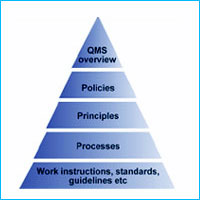HACCP
The trade scenario has changed world over especially after the WTO agreements came into effect. Codex Alimentarius Commission recommended standards and guidelines regarding various aspects of Food Processing industry. These requirements have become benchmark for international trade. HACCP System for food safety management has become global requirement of international trade as a measure of installing higher confidence in food safety. Government has an important role in facilitating systems that promote greater food safety and awareness.
The Codex Alimentarius General Principles of Food Hygiene lay a firm foundation for ensuring effective food control and food hygiene. The General Principles of food hygiene follow the food chain from primary production to the consumer, highlighting the key hygiene controls at each stage. Codex has established HACCP based approach to ensure food safety as a benchmark in the International Food Trade. A Hazard Analysis And Critical Control Point (HACCP) approach is recommended wherever possible to enhance food safety. The HACCP approach is internationally recognized as being effective in ensuring the safety and suitability of food for human consumption and in international trade.
The HACCP System, as it applies to food safety management, uses the approach of controlling critical points in food handling to prevent food safety problems. Besides enhancing food safety, other benefits applying HACCP include effective use of resources and timely response to food safety problems. In addition, the application of the HACCP system can result in more focused risk management by food control regulatory authorities and can promote international trade by increasing buyer confidence in food safety.
The HACCP system identifies specific hazards and control measures to ensure the safety of food. A HACCP plan is specific to the particular food and processing application. The HACCP system is capable of accommodating changes such as advances in equipment design, new information concerning health hazards or risks, new processing procedures or technological developments.
The history and background of the HACCP System
The objective is to introduce the trainees to the history and background of the Hazard Analysis and Critical Control Point (HACCP) system and its importance as a food safety management system in identifying and controlling food safety hazards.
The HACCP System for managing food safety concerns grew from two major developments. The first breakthrough was associated with W.E. Deming, whose theories of quality management are widely regarded as a major factor in turning around the quality of Japanese products in the 1950's. Dr. Deming and others developed total quality management (TQM) systems which emphasised a total systems approach to manufacturing that could improve quality while lowering costs.
The second major breakthrough was the development of the HACCP concept itself. The HACCP concept was pioneered in the 1960's by the Pillsbury Company, the United States Army and the US National Aeronautics and NASA as a collaborative development for the production of safe foods for the US space programs. Pillsbury introduced and adopted HACCP as the system that could provide the greatest safety while reducing dependence on end product inspection and testing.
Recognizing the importance of HACCP to food control, the 20th session of Codex Alimentarius Commission held in Geneva Switzerland adopted Guidelines for the application of Hazard Analysis Critical Control Point (HACCP).
Advantages of HACCP
The HACCP system as it applies to food safety management uses the approach of controlling critical points in food handling to prevent food safety problems. The system which is science based and systematic identifies specific hazards and measures for their control to ensure the safety of food. HACCP is based on prevention and reduces the reliance on end product inspection and testing.
The HACCP system can be applied throughout the food chain from the primary producer to the consumer. Besides enhancing food safety, other benefits of applying HACCP include more effective use of resources, savings to the food industry and more timely response to food safety problems. HACCP enhances the responsibility and degree of control at the level of the food industry. A properly implemented HACCP system leads to greater involvement of food handlers in understanding and ensuring food safety, thus providing them with renewed motivation in their work. Implementing HACCP does not mean undoing quality assurance procedures or good manufacturing practices already established by a company, it does, however, require a revision of these procedures as part of the systematic approach and for their appropriate integration into the HACCP plan.
The application of the HACCP System can aid inspection by food control regulatory authorities and promote international trade by increasing buyer's confidence.
Any HACCP system should be capable of accommodating change, such as advances in equipment design, changes in processing procedures or technological developments.
The HACCP technique does this by identifying the risks, establishing critical control points, setting critical limits, and ensuring control measures are validated, verified and monitored before implementation.
The effective implementation of HACCP will enhance the ability of companies to: protect and enhance brands and private labels, promote consumer confidence and conform to regulatory and market requirements.

Quality management guarantee – It guarantees that the products and services of the organization satisfies the customer's quality requirements and comply with all the regulations applicable to those products or services.
